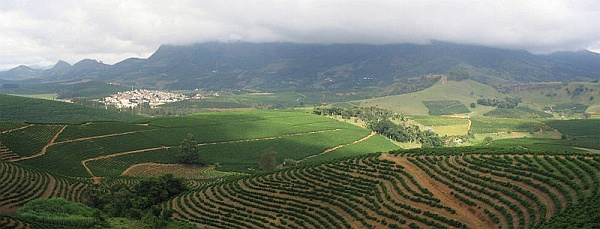
Here’s a photograph of a coffee plantation in the mountains of Brazil.
What’s wrong with this picture?
The trees are missing. And so are the birds.
Last week the University of Utah announced the results of a new study on bird diversity that compared intact tropical forest, agroforests, and open farmland. The result was not surprising: Birds do better in agroforests than on farms.
Agroforests are “a type of farm where the crops are grown under trees at a reasonable density,” according to study author Çagan Sekercioglu. “Often, it’s not like forest-forest — it feels more like a open park.”
In the past, coffee and chocolate crops were both grown in agroforests — or in full tropical forest — because they are shade-loving plants.
But agri-business found even moderately shady habitat too labor intensive. Always on the lookout for ways to cut costs, they bred coffee bushes to tolerate full sun. For the past two decades they have cleared land, planted coffee in the sun, and harvested it mechanically.
Sadly, bird diversity drops as the habitat becomes more open. The study analyzed over 6,000 species and found that the more open the land, the fewer insect-eaters (flycatchers and warblers), fruit eaters (orioles and parrots), and nectar-eaters (hummingbirds). Agroforests can support many of these species but the study showed that open farmland supports only seed and grain eaters — and these birds are often considered pests.
Does open farmland south of the border affect “our” birds?
Yes. Most of our breeding forest birds are neotropical migrants who spend less than half their lives in North America. The majority of their time is spent in tropical forests — or agroforests — in Central and South America.
Every year there are fewer intact forests and fewer agroforests. Meanwhile many of our neotropical migrants are in decline including cerulean warblers and scarlet tanagers.
You can help. Your coffee is good for birds if it’s made in the shade.
How do you know if coffee is shade-grown?
Check the label for bird-friendly, shade-grown certification by a trustworthy environmental organization such as the Smithsonian Migratory Bird Center (SMBC) or the Rainforest Alliance. (Unfortunately some manufacturers have co-opted the term shade-grown because they know it’s worth more.)
Certified bird-friendly coffee and chocolate(!) aren’t always easy to find. If you have a favorite place to buy them, let us know by leaving a comment.
(photo by Fernando Rebêlo from Wikimedia Commons. Click on the caption to see the original)
Click here for more on the University of Utah bird study.
In order to get the same yield of coffee beans, wouldn’t you need to clear more intact tropical forest to create the agroforest? Perhaps that could reduce the habitat even more. Maybe we should just drink less coffee to reduce the market for the beans.
Actually the growers bred full sun coffee to get higher yields, but full sun coffee needs pesticides to thrive & the plants don’t live as long. The open farmland method is not good for the soil either.
Yes, I/we should drink less coffee.
🙁
It’s one of my vices.
I don’t drink a ton of coffee, but when I do indulge I drink “bird-freindly.” I’ve done a decent amount of research. What I found out is that the Smithsonian certification is the most rigorous, but some small companies cannot spend the money to obtain and maintain the certification as they are struggling farmers of modest means. Hence, I try to research the shade-grown coffee I come across available for retail sale in my local stores and then I go with my gut based on the available information.
Scott Shalaway has discussed and written about this topic extensively. He has a relationship with Golden Valley Farms – see
http://www.goldenvalleyfarms.com/coffee101/birdfriendlycoffees.asp
which is the only coffee roaster that produces 100% shade-grown coffee. All the others which are shade-grown are not 100%, and they are allowed to do this.
Scott even has a specialty coffee with his name on it with Golden Valley Farms.
http://secure.goldenvalleyfarms.com/home.php?cat=38
This from a non-coffee drinker!
I started buying shade-grown coffee about 15 years ago at Hawk Mountain whenever I was there. They were selling an Audubon branded roast that some proceeds also went to the AUdubon Society, as well as the mark-up that Hawk Mountain made (we’re members, so we would buy stuff there on purpose).
They don’t seem to have it on the Hawk Mountain online store, but they currently are selling Birds & Beans branded coffees.
http://www.birdsandbeans.com/index.html
For local “grab-n-Go” Caribou has all Rainforest Alliance brews (Their goal was to be at 100% by the end of 2011, I think they made it) and if you read the package, it will give you some idea of where the coffee is coming from.
For example, one of their seasonal coffees is La Minita Peaberry. If you read about the estate, you can get and idea of what kind of trees are grown with the coffee (example here: http://www.wilsonscoffee.com/carticles/costarica.html)
According to the info here:
http://www.coffeehabitat.com/2006/02/what_is_shade_g/
…that’s pretty much the minimum for “shade-grown (one layer of trees, and they even cut them back!). So for bird/bio-diversity…not so much.
We sell Equal Exchange coffee and chocolate at our church – The Unitarian Universalist Church of the North Hills-in Franklin Park. It is fair trade coffee and 90% of it is organic. Not all of it is shade grown as they do help out the farmers in areas that have already been deforested. See the link below. Great topic, thanks, Kate.
http://www.equalexchange.coop/is-your-coffee-shade-grown
Cornell Lab of Ornithology has a coffee guide here: http://bit.ly/WOZ8vy